Design of a High Sensitivity Pirani Gauge Based on Vanadium Oxide Film for High Vacuum Measurement
Abstract
:1. Introduction
2. Principle and Heat Transfer
- Solid conduction from cantilever beam to its carrier (); the value of the thermal conductance depends on the geometry of the sensor’s carrier and its thermal conductivity.
- Radiation from the sensor’s hot surface to the surface of the chamber (); its value depends on the emissivity and the exterior surface of the sensor.
- Gas convection and conduction (); this effectively depends on pressure.
2.1. Solid Conduction
2.2. Radiation
2.3. Gas Convection and Conduction
3. Design and Simulation
3.1. Material
3.2. VOx TCR Measurement
3.3. Structure and Readout Circuit Design
3.4. Fabrication Process Design
3.5. Simulation of Pirani Gauge
4. Optimization of Pirani Gauge Parameters
4.1. Support Layer Materials
4.2. Thickness
4.3. Thermal Sensitive Area
4.4. The Depth of the Cavity
5. Conclusions
Author Contributions
Funding
Institutional Review Board Statement
Informed Consent Statement
Data Availability Statement
Acknowledgments
Conflicts of Interest
References
- Wang, X.; Liu, C.; Zhang, Z.; Liu, S.; Luo, X. A micro-machined Pirani gauge for vacuum measurement of ultra-small sized vacuum packaging. Sens. Actuators A Phys. 2010, 161, 108–113. [Google Scholar] [CrossRef]
- Dong, T.; Xiao, B.; Elfving, A.; Yang, Z.; Tran-Minh, N.; Halvorsen, E.; Hoivik, N. Pirani gauge based hermeticity monitoring for un-cooled micro bolometer array. In Proceedings of the 2009 16th IEEE International Symposium on the Physical and Failure Analysis of Integrated Circuits, Suzhou, China, 6–10 July 2009; pp. 438–442. [Google Scholar]
- Xiao, B.; Dong, T.; Halvorsen, E.; Yang, Z.; Zhang, Y.; Hoivik, N.; Gu, D.; Tran, N.M.; Jakobsen, H. Integrated micro Pirani gauge based hermetical package monitoring for uncooled VO x bolometer FPAs. Microsyst. Technol. 2011, 17, 115–125. [Google Scholar] [CrossRef]
- Wei, D.; Fu, J.; Liu, R.; Hou, Y.; Liu, C.; Wang, W.; Chen, D. Highly Sensitive Diode-Based Micro-Pirani Vacuum Sensor with Low Power Consumption. Sensors 2019, 19, 188. [Google Scholar] [CrossRef] [PubMed] [Green Version]
- Mitchell, J.; Lahiji, G.R.; Najafi, K. An improved performance poly-Si Pirani vacuum gauge using heat-distributing structural supports. J. Microelectromech. Syst. 2008, 17, 93–102. [Google Scholar] [CrossRef]
- Wang, S.; Mizuno, K.; Fujiyoshi, M.; Funabashi, H.; Sakata, J. Thermal micropressure sensor for pressure monitoring in a minute package. J. Vac. Sci. Technol. A Vac. Surf. Film. 2001, 19, 353–357. [Google Scholar] [CrossRef]
- Garg, M.; Arya, D.S.; Sharma, S.; Kumar, S.; Uddin, W.; Das, S.; Chiu, Y.; Singh, P. Highly Responsive Metal Oxide (V2O5)-Based NEMS Pirani Gauge for In-Situ Hermeticity Monitoring. J. Microelectromech. Syst. 2021, 30, 340–342. [Google Scholar] [CrossRef]
- Topalli, E.S.; Topalli, K.; Alper, S.E.; Serin, T.; Akin, T. Pirani vacuum gauges using silicon-on-glass and dissolved-wafer processes for the characterization of MEMS vacuum packaging. IEEE Sens. J. 2009, 9, 263–270. [Google Scholar] [CrossRef]
- Chae, J.; Stark, B.H.; Najafi, K. A micromachined Pirani gauge with dual heat sinks. IEEE Trans. Adv. Packag. 2005, 28, 619–625. [Google Scholar]
- Liu, C.; Fu, J.; Hou, Y.; Zhou, Q.; Chen, D. A Self-Calibration Method of Microbolometer With Vacuum Package. IEEE Sens. J. 2020, 20, 8570–8575. [Google Scholar] [CrossRef]
- Kim, G.; Seok, C.; Kim, T.; Park, J.H.; Kim, H.; Ko, H. The micro pirani gauge with low noise CDS-CTIA for in-situ vacuum monitoring. JSTS J. Semicond. Technol. Sci. 2014, 14, 733–740. [Google Scholar] [CrossRef]
- Sun, Y.-C.; Liang, K.-C.; Cheng, C.-L.; Lin, M.-Y.; Chen, R.-s.; Fang, W. Performance improvement of CMOS-MEMS Pirani vacuum gauge with hollow heater design. In Proceedings of the 2015 Transducers-2015 18th International Conference on Solid-State Sensors, Actuators and Microsystems (TRANSDUCERS), Anchorage, Alaska, 21–25 June 2015; pp. 1069–1072. [Google Scholar]
- Kong, Y.; Jiao, B.; Zhang, L.; Yun, S.; Chen, D. Design and fabrication of wafer-level packaged MEMS Pirani gauge with sorrounded heat sinks. In Proceedings of the 2017 19th International Conference on Solid-State Sensors, Actuators and Microsystems (TRANSDUCERS), Kaohsiung, Taiwan, 18–22 June 2017; pp. 950–953. [Google Scholar]
- Mo, J.; Middelburg, L.M.; Morana, B.; Van Zeijl, H.; Vollebregt, S.; Zhang, G. Surface-micromachined silicon carbide Pirani gauges for harsh environments. IEEE Sens. J. 2020, 21, 1350–1358. [Google Scholar] [CrossRef]
- Grau, M.; Völklein, F.; Meier, A.; Kunz, C.; Kaufmann, I.; Woias, P. Optimized MEMS Pirani sensor with increased pressure measurement sensitivity in the fine and rough vacuum regimes. J. Vac. Sci. Technol. A Vac. Surf. Film. 2015, 33, 021601. [Google Scholar] [CrossRef]
- Lecler, S.; Marconot, O.; Fréchette, L.G. SiO2/SiN membranes as MEMS Pirani gauges for wide pressure measurement range. In Proceedings of the 2019 IEEE SENSORS, Montreal, QC, Canada, 27–30 October 2019; pp. 1–4. [Google Scholar]
- Chen, Y.-C.; Lin, W.-C.; Wang, H.-S.; Fan, C.-C.; Lin, K.C.-H.; Chou, B.C.; Liu, M.C.-M. Differential micro-Pirani gauge for monitoring MEMS wafer-level package. In Proceedings of the 2015 28th IEEE International Conference on Micro Electro Mechanical Systems (MEMS), Estoril, Portugal, 18–22 January 2015; pp. 89–92. [Google Scholar]
- Völklein, F.; Grau, M.; Meier, A.; Hemer, G.; Breuer, L.; Woias, P. Optimized MEMS Pirani sensor with increased pressure measurement sensitivity in the fine and high vacuum regime. J. Vac. Sci. Technol. A Vac. Surf. Film. 2013, 31, 061604. [Google Scholar] [CrossRef]
- Toto, S.; Nicolay, P.; Morini, G.L.; Rapp, M.; Korvink, J.G.; Brandner, J.J. Design and Simulation of a Wireless SAW–Pirani Sensor with Extended Range and Sensitivity. Sensors 2019, 19, 2421. [Google Scholar] [CrossRef] [PubMed] [Green Version]
- Toto, S.; Nicolay, P.; Morini, G.L.; Voigt, A.; Korvink, J.G.; Brandner, J.J. Toward a Compact Wireless Surface Acoustic Wave Pirani Microsensor with Extended Range and Sensitivity. Heat Transf. Eng. 2021, 42, 565–578. [Google Scholar] [CrossRef]
- Xu, S.; Shi, M.; Zhou, N.; Zhao, Y.; Mao, H.; Huang, C. A Performance Enhancement Method for MEMS Thermopile Pirani Sensors through In-Situ Integration of Nanoforests. IEEE Electron Device Lett. 2022, 43, 1752–1755. [Google Scholar] [CrossRef]


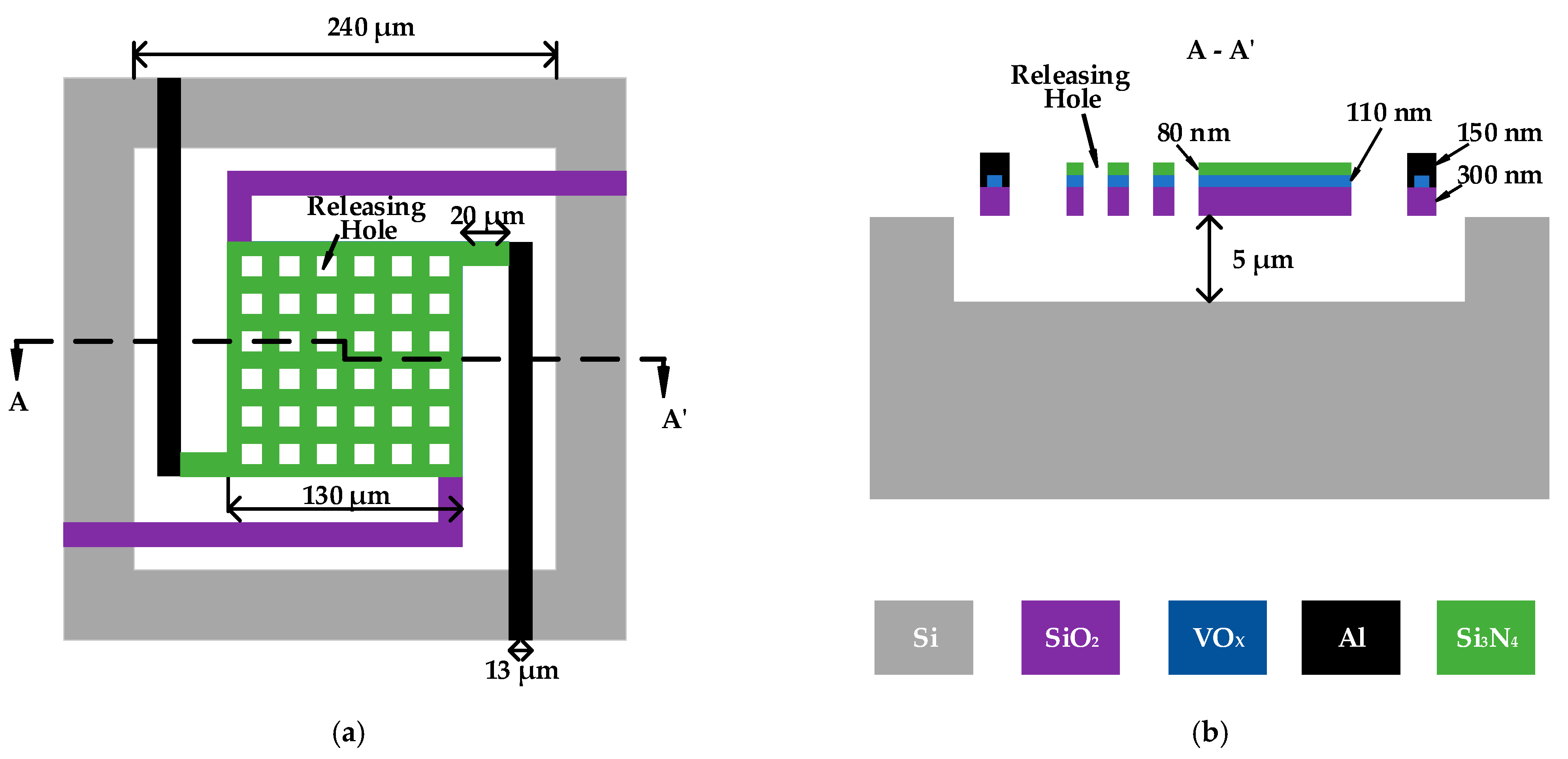

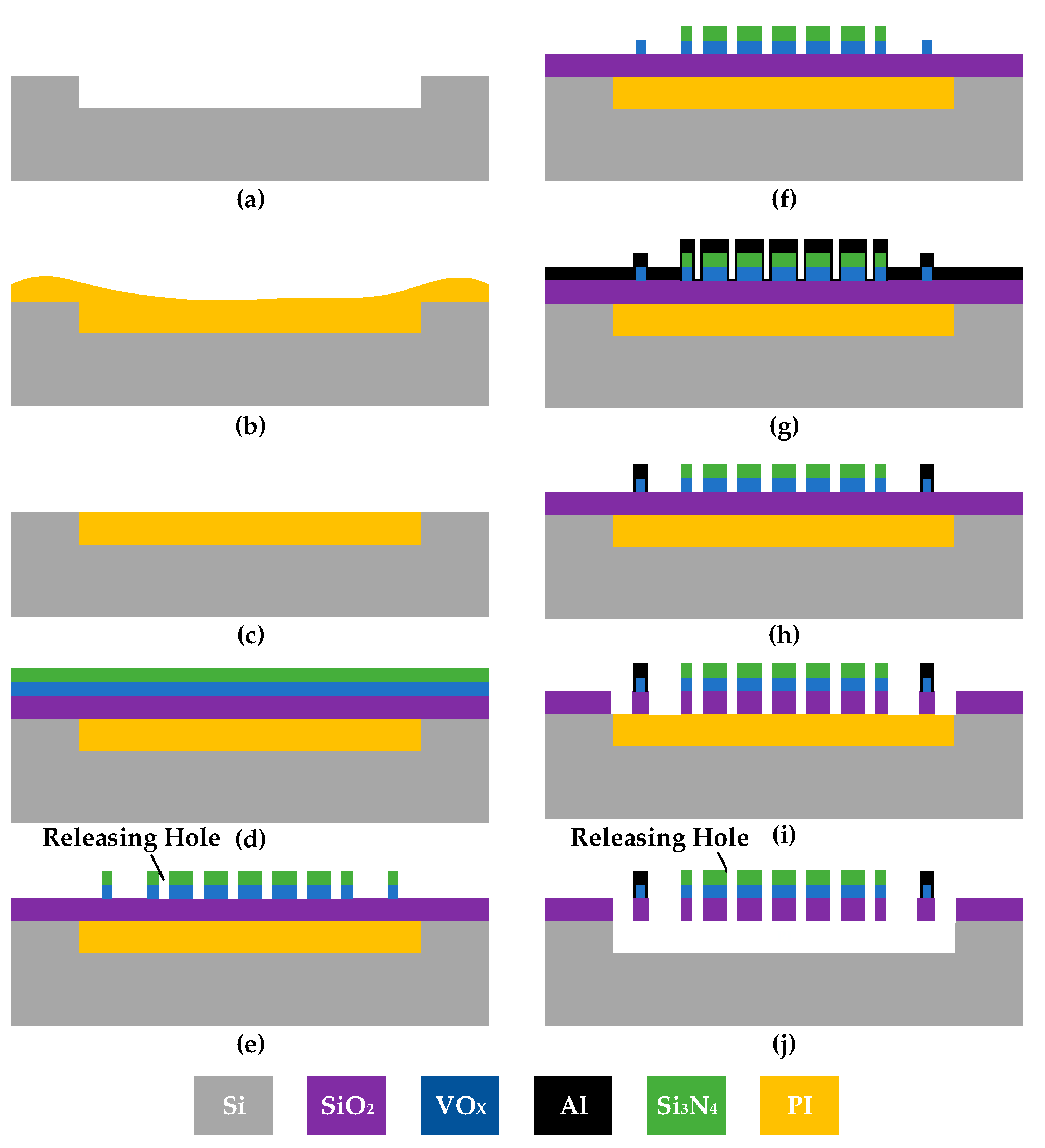
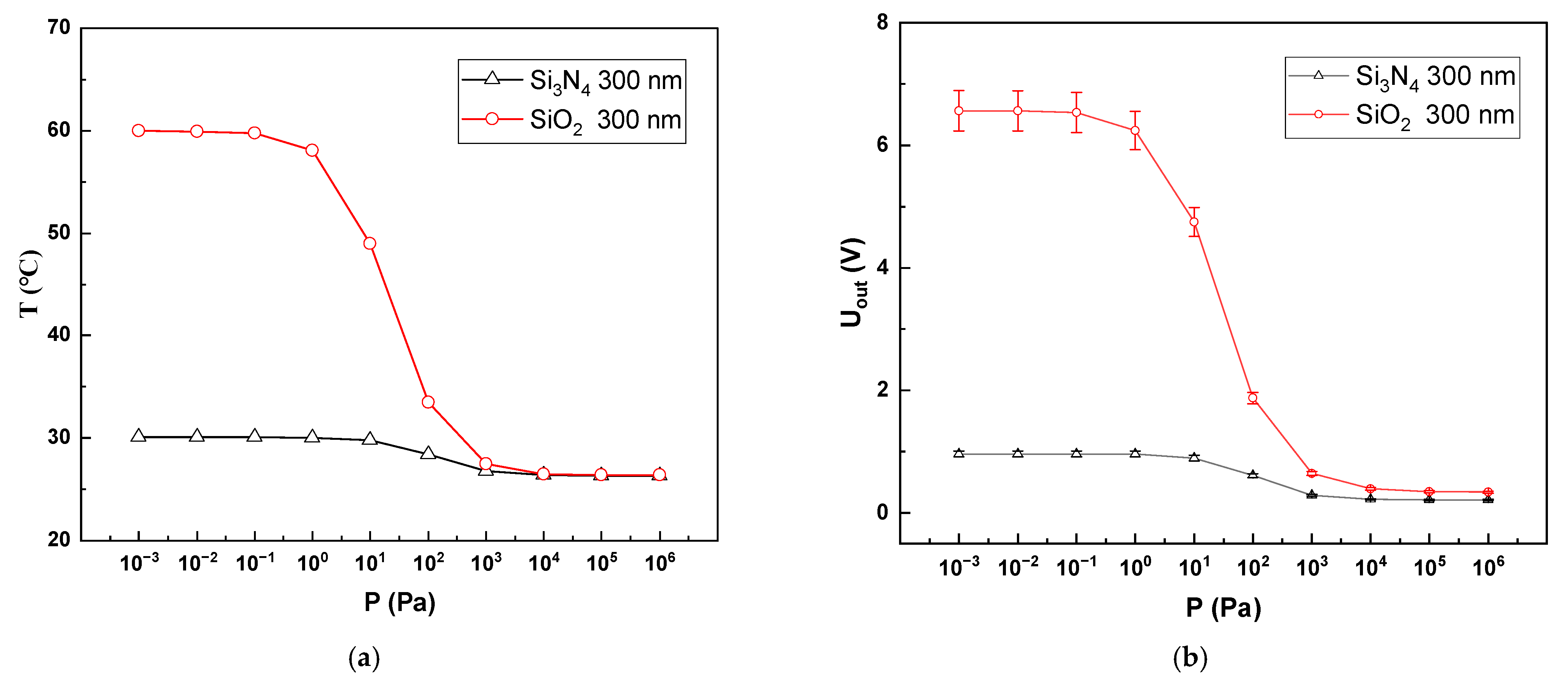
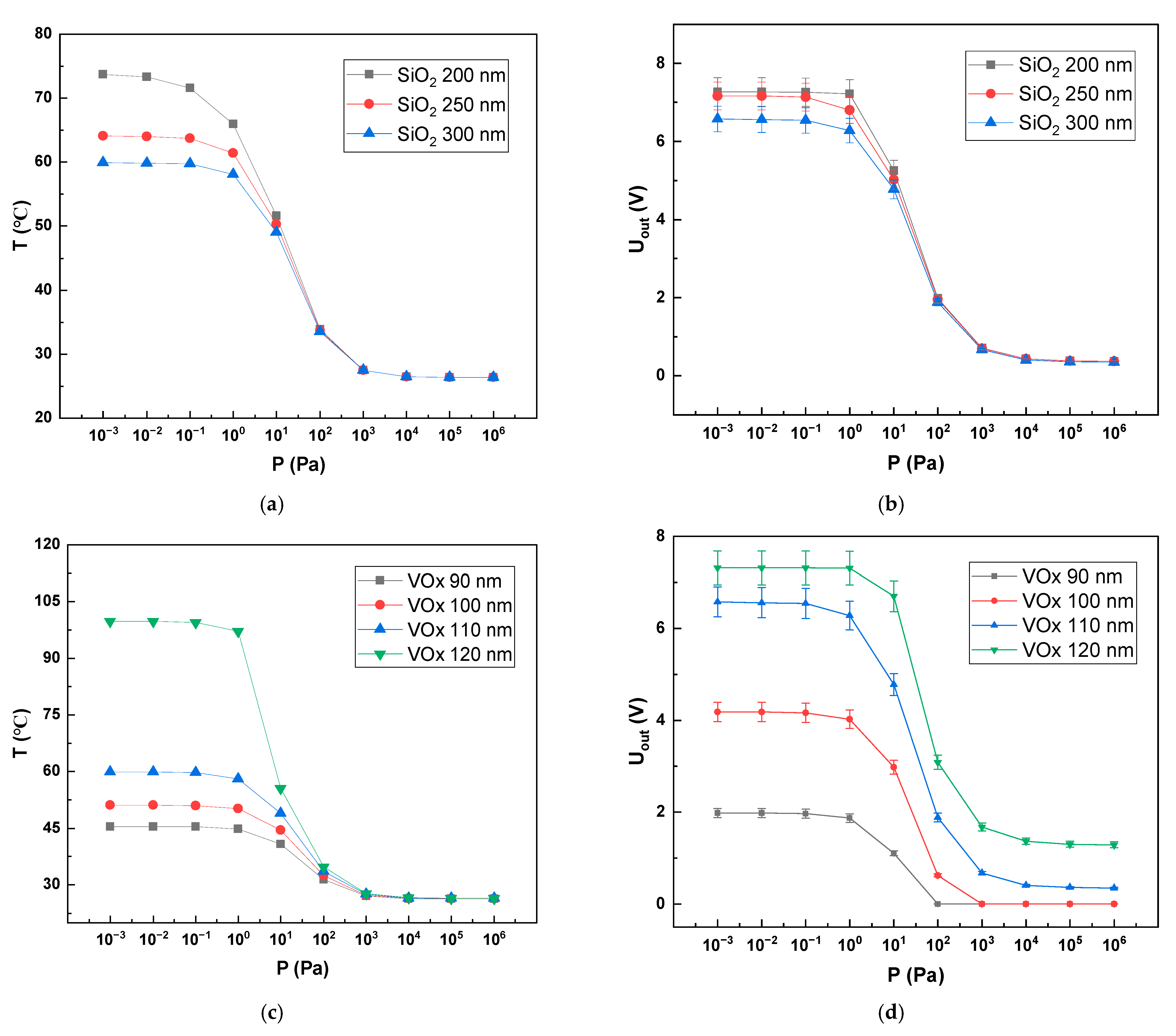
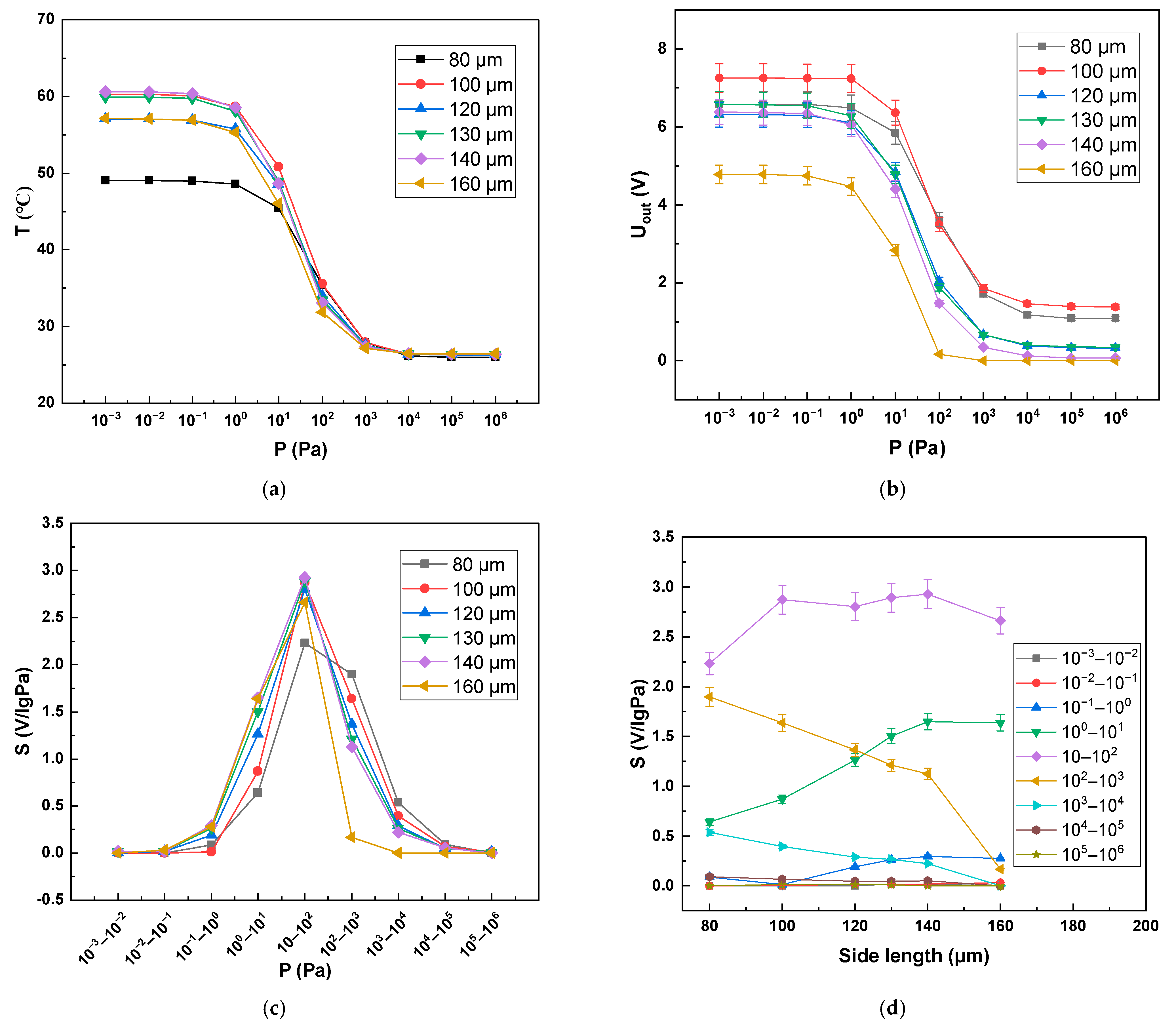
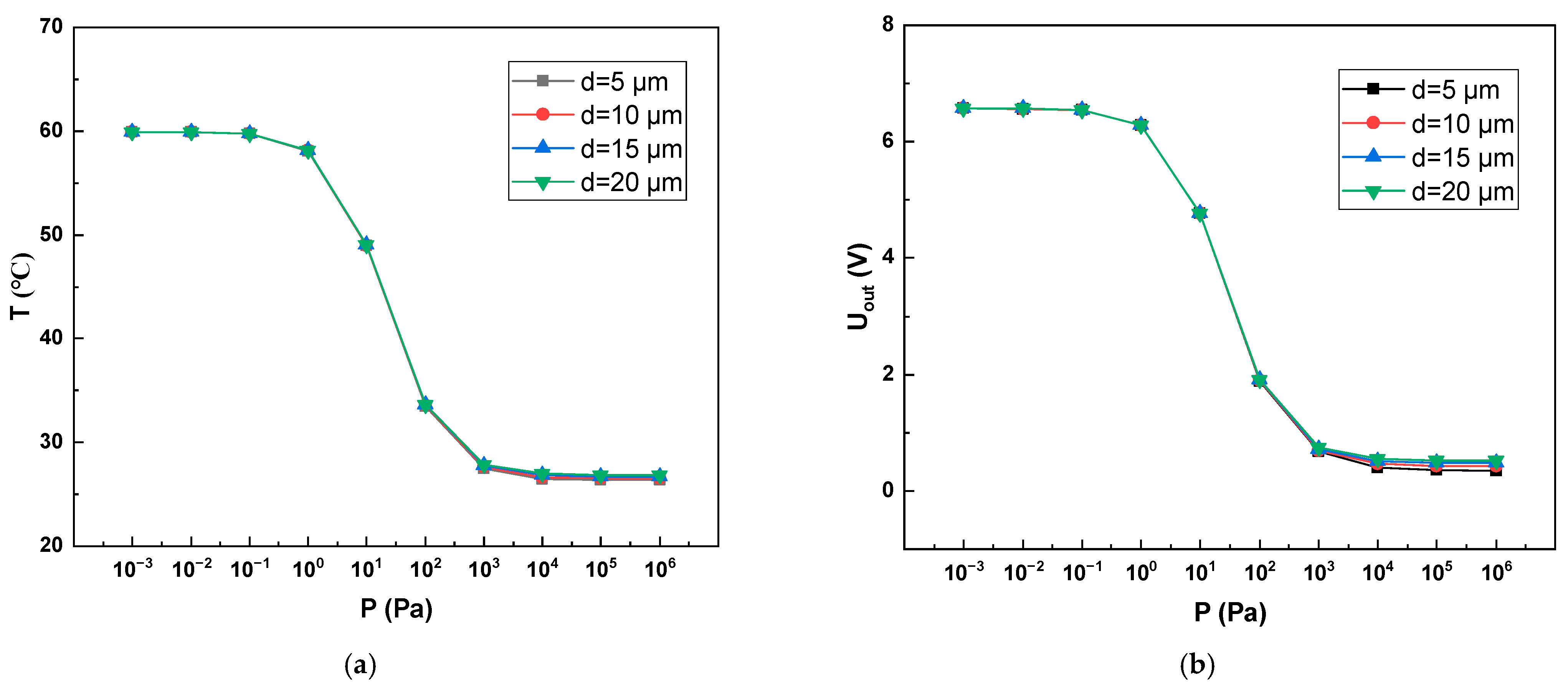
| Researcher | Type of Gauge | Pressure Range (Pa) |
|---|---|---|
| Mitchell, J., et al. (2008) [5] | Microbridge | 0.1~1 × 103 6.7~1 × 105 |
| Chen, Y.-C., et al. (2015) [17] | Microbridge | 6.7~1.3 × 104 |
| Wang, S., et al. (2001) [6] | Resistor on dielectric membrane (Ti) | 7 × 10−3~1 × 105 |
| Chae, J., et al. (2005) [9] | Resistor on dielectric membrane (Cr/Pt) | 2.7~266.6 |
| Lateral heat transfer (P++ silicon) | ||
| Dong, T., et al. (2009) [2] | Resistor on dielectric membrane (Si/Ge) | 0.1~100 |
| Wang, X., et al. (2010) [1] | Resistor on dielectric membrane (Pt) | 1~300 |
| Völklein, F., et al. (2013) [18] | Resistor on dielectric membrane (Ni) | 1.3 × 10−4~133 |
| Grau, M., et al. (2015) [15] | Resistor on dielectric membrane (Ni) | 0.1~1 × 105 |
| Lecler, S., et al. (2019) [16] | Resistor on dielectric membrane (Ni) | 10−2~105 |
| Wei, D., et al. (2019) [4] | Resistor on dielectric membrane (Series diode) | 10−1~104 |
| Liu, C., et al. (2020) [10] | Resistor on dielectric membrane (Series diode) | 1~500 |
| Topalli, E. S., et al. (2009) [8] | P++silicon coil microbridge 100μm thick silicon coil microbridge | 1.3~266.6 6.7~666.6 |
| Kim, G., et al. (2014) [11] | Resistor on dielectric membrane (boron-doped α-Si) | 13.3~1333 |
| Sun, Y.-C., et al. (2015) [12] | Heater-with-holes | 27~2.7 × 104 |
| Kong, Y., et al. (2017) [13] | Comb-shape structure | 0.5~2.6 × 103 |
| Mo, J., et al. (2020) [14] | Suspension of poly-SiC membrane | 10~105 |
| Xiao, B., et al. (2011) [3] | Resistor on dielectric membrane (VOx) | 1~100 |
| Garg, M., et al. (2021) [7] | Suspension of V2O5 membrane | 4~2.7 × 103 |
| This Work | Resistor on dielectric membrane (VOx) | 10−1~104 |
Publisher’s Note: MDPI stays neutral with regard to jurisdictional claims in published maps and institutional affiliations. |
© 2022 by the authors. Licensee MDPI, Basel, Switzerland. This article is an open access article distributed under the terms and conditions of the Creative Commons Attribution (CC BY) license (https://creativecommons.org/licenses/by/4.0/).
Share and Cite
Guo, S.; Feng, L.; Chen, S.; Ji, Y.; Peng, X.; Xu, Y.; Yin, Y.; Wang, S. Design of a High Sensitivity Pirani Gauge Based on Vanadium Oxide Film for High Vacuum Measurement. Sensors 2022, 22, 9275. https://doi.org/10.3390/s22239275
Guo S, Feng L, Chen S, Ji Y, Peng X, Xu Y, Yin Y, Wang S. Design of a High Sensitivity Pirani Gauge Based on Vanadium Oxide Film for High Vacuum Measurement. Sensors. 2022; 22(23):9275. https://doi.org/10.3390/s22239275
Chicago/Turabian StyleGuo, Song, Liuhaodong Feng, Shuo Chen, Yucheng Ji, Xinlin Peng, Yang Xu, Yong Yin, and Shinan Wang. 2022. "Design of a High Sensitivity Pirani Gauge Based on Vanadium Oxide Film for High Vacuum Measurement" Sensors 22, no. 23: 9275. https://doi.org/10.3390/s22239275





